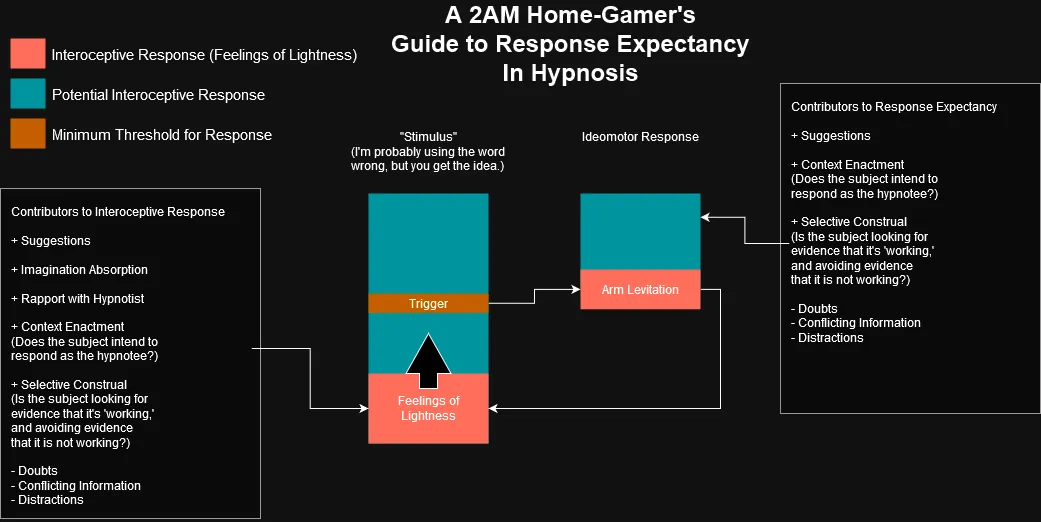501 - Response Expectancy
Sometimes it takes a little help to get it up… /music
This is loosely based on the ideas in Hypnotic involuntariness and the automaticity of everyday life by Irving Kirsch and Steven Jay Lynn.
WTF is Response Expectancy
Section titled “WTF is Response Expectancy”According to Irving Kirsch, a response expectancy as an anticipation of automatic reactions in response to a particular stimuli. They tend to be self-confirming, in that they generate both the subjective and physiological responses. In layman terms, they’re a self-fulfilling prophecy. For our purposes today, when our arm feels light enough, it’ll begin to rise all on it’s own.
Hopefully your hypnotee’s cool with you borrowing control of their arm for a bit. We’ll be making an example of it.
Here’s a cool chart I made at 2AM. You’ll probably do better just reading the text, I probably fucked stuff up in the chart.

The Setup
Section titled “The Setup”This part’s easy. You’ve got a willing subject, and they’ve accepted you as their hypnotist. They expect to respond automatically to your suggestions. Inside this theory, two parts of this lead to this feeling ‘automatic.’ First, part of the ‘hypnotic contract’ is that responses will feel automatic, creating expectancy. The second part is that there’s a generalized implementation intention that can fall out of your awareness. It’s like when you’re in a clusterfuck of a city, your GPS is freaking out, and your friend offers to chime in with some directions. After a bit of following along, much like Simon Says, if they asked you to turn right, you’d probably turn right without a second thought.
Here’s a bit of a pickle if we stay within this framework. As a hypnotist, it’s perfectly reasonable and expected to ask your subject to work with your suggestions. So - if you ask them to make their arm feel heavy as if you were weighing it down with lead, they would do it without it affecting their sense of automaticity. This is where that implementation intention comes in. When we finally have our subjects wound up enough and we can see their arm wavering a bit, we can suggest it’ll start to lower on it’s own. We’re just asking them to not fight it when it feels it’s happening automatically.
If we asked them to just lower their arm, we’d break the first and second components. Firstly, we’re asking them to do something that won’t feel automatic, and we’re asking them to do something outside of the generalized implementation intention - where they decide to lower their arm, rather than the intention coming from the hypnotic contract.
I want to do a whole ass writeup on improving responsiveness, but here’s a few tips you might not have heard in popular recreational hypnotic literature…
- Ask your subject to actively engage with suggestions and their imagination.
- They don’t like your suggestions? They can’t imagine their arm being filled with lead? That’s cool - what works for them? Ask.
- Getting into the surprisingly direct part - suggest that for the highest quality best response, they should focus on indicators that things are working. Or - in a more fun way, if you reject the idea that you’re being hypnotized in the middle of your session, you’re going to have less fun.
- Reframe failure as experiments and data. This is a skill to be trained and you’re teaming up.
- Tell them you don’t want them to force anything or fight anything, just experience what they experience. If they feel their arm moving automatically, let it. From the cognitive behavior perspective, this lets them reframe their response as automatic. (And… as an occasional subject, despite knowing all this theory, this does not stop how fucking automatic all this feels.)
- If they need to employ some of these helper strategies in the beginning, they might find that later they don’t need them when they’ve got their response dialed in.
- Hold your arm out. Yeah, like right now. Notice how unsteady that is? You can utilize that.
Suggestions as Triggers
Section titled “Suggestions as Triggers”Ever heard a hypnotist build up a trigger? That’s exactly what you’re doing* when you’re setting up an arm levitation.
*…for illustrative purposes and cherry picked examples…
So, here’s the suggestion components.
- Tell them that when their arm feels light enough, it’ll begin to rise on it’s own.
- Cheat code - they may notice it beginning to rise more easily on the in-breath since the hypnotic response is fighting less against gravity. Let it.
- Check for understanding and compliance.
- Ask them to close their eyes
- Start going ham suggesting whatever makes their arm light.
- Utilize (reinforce) like a mofo when you see it start.
Feel free to gesture and have fun here, assuming you’re in a recreational space. Do some silly hand movement, not touching their hand. It’ll give them something fun to attribute the movement to, you get to have fun, and their movement will feel more automatic. You can even use changes in your voice as a cue. That’s also why finger-snaps work (in this model,) it’s an option for expectation attribution, fulfilling the requirements. Neat huh?
Focus and Imagination
Section titled “Focus and Imagination”Why the hell do people ask subjects to close their eyes during an induction anyway? Good question!
- It helps the subject focus on their imagination.
- It helps the subject be able to notice subtle changes in their interoception, especially if you ask them to look for the tiniest possible change begin. If you’re okay throwing in a little hypno-fun language, you can suggest that they’re waiting for the subconscious to agree with your suggestion. It’s bullshit, but depending on your subject, they’ll probably be on board.
- It reduces distractions. They won’t even notice the guy getting cheesed behind them.

This is a Tool - Not a Silver Bullet
Section titled “This is a Tool - Not a Silver Bullet”Remember that - this is just a model of how things can work. Integrate this with the rest of your tools. Even Lynn admitted this could only be a 30% boost to hypnotic response - which is great!
I think the big thing about response expectancy is that it was heavily pushed by Kirsch to begin with, but Reategui had big questions about it.
And Lynn says
It thus remains a viable question why substantial variability exists in correlations of expectancies and hypnotic responsiveness ranging from nonsignificant to high (above .50). Even the most optimistic estimates of the link between expectancy and hypnotic response hover in the range of about 25 to 35% of the variability accounted for in hypnotic responses. It has become increasingly apparent that whereas expectancy may mediate the relations of diverse variables to varying extents, it is necessary to consider multiple variables to provide a more satisfactory account of how participants respond to hypnotic suggestions.
Not that any of this is going to matter: 25% to 35% is a pretty huge chunk, and if you can get an extra 30% you should totally go for it.
But… it’s not the 90% that Kirsch was pushing originally, and Lynn’s “readiness response set” is (by his own admission) barely studied. There’s still a ton we don’t know.
-Binaural Histolog, from Reddit.
Shit - I Crashed and Burned
Section titled “Shit - I Crashed and Burned”It happens! This is why it’s very important to pre-frame this as an experiment. You don’t need to blow everything if you didn’t see their arm move. Ask them how it felt. They may have felt like their arm was starting to lift!
If things still aren’t moving along, you might have to ask them to help “start” the feeling. It’s not about imagining harder, it’s about looking for that tiniest movement, and letting it start to happen. If you’re in meatspace, you can tell them that in a moment, you’ll tap their hand, and it’ll start to move all on it’s own.
If that doesn’t go, no big! Tell them they did great, and reinforce that you’re here to have fun, and they’re a great hypnotic subject. It’s a skill that needs to be built, so they’re probably just a few more tries away from getting it to go.
Beyond Response Expectancy
Section titled “Beyond Response Expectancy”This (older) response set theory was superseded by two important papers. I still have yet to read them both, so I’m going to quote Binaural Histolog and send you their direction, along with their citations.
Response set theory (1997) builds on response expectancy theory to add automaticity by talking about behavior in terms of automatic sets of responses that we only think we have control over. The very short version is that conscious thought is the very last step in the chain of processing; by the time we decide to do things, the brain has already decided to do it for us. A follow up paper, The Response Set Theory of Hypnosis (2000), cleared up some misconceptions on the earlier paper, but still held that actions are fully automatic.
Integrative response set theory (2022) steps back from fully automatic actions, instead saying that varying degress of automaticity precede actions, and uses a “weak” model of response expectancy that reflects more recent studies. The integrative theory provides a practical mechanism for response expectancies by integrating the model with the hierarchical predictive processing model in cognitive neuroscience, stating “an expectancy is by definition a prediction.”
-Binaural Histolog - Response Set Theory